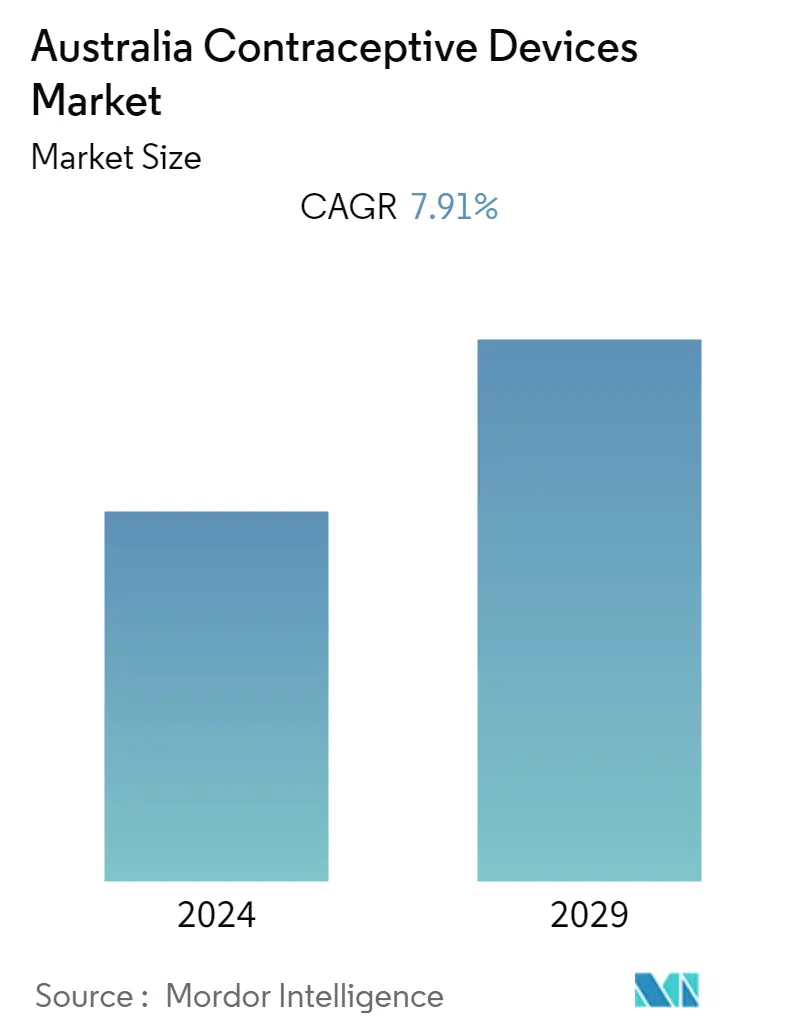Market Size of Australia Contraceptive Devices Industry

| Study Period | 2019 - 2029 |
| Base Year For Estimation | 2023 |
| Forecast Data Period | 2024 - 2029 |
| Historical Data Period | 2019 - 2022 |
| CAGR | 7.91 % |
| Market Concentration | Low |
Major Players
*Disclaimer: Major Players sorted in no particular order |
Australia Contraceptive Devices Market Analysis
The Australian contraceptive devices market is expected to register a CAGR of nearly 7.91% during the forecast period.
Millions of women and girls worldwide had lost access to contraceptive and abortion services due to the COVID-19 epidemic. Lockdowns, travel restrictions, supply chain disruptions, and a significant shift in health resources to battle COVID-19 have contributed to the rise in the number of unintended pregnancies in the country. Also, according to the study published in the European Journal of Contraceptives and Reproduction in August 2022, women who were working had easier access to contraceptives during the shutdown. COVID-19 caused people to postpone childbearing or decide against having children. Thus, during the pandemic, a greater percentage of women were against childbearing, which created a demand for contraception. As a result, the investigated market was positively impacted during the epidemic. However, the studied market will follow the same trend during the forecast period due to the growing burden of sexually transmitted diseases and the rising demand for contraceptives in Australia. For instance, according to the press release by Durex in September 2021, the company saw a 10% increase in condom sales once restrictions were relaxed in Sydney, Australia.
Rising cases of sexually transmitted diseases and the initiatives taken by the government of Australia and other organizations concerning the use of contraceptive devices are the major factors responsible for the growth of the market studied.
Sexually transmitted diseases include AIDS/ HIV, Gonorrhoea, Hepatitis, Human Papillomavirus (HPV), and Pelvic Inflammatory Disease (PID), and the growing prevalence of these diseases is expected to increase the demand for contraceptive devices. According to the 2022 update by the AFAO, 29,090 persons in Australia were affected by HIV in 2020. Thus, the growing prevalence of HIV in the country is expected to increase the demand for contraceptive devices, thereby boosting the market growth.
Furthermore, government initiatives are expected to support market growth. For instance, in May 2022, Moments Condoms, a Melbourne-based company, is on a mission to inspire more women to take the initiative to preserve their sexual health. Such initiatives increase the availability of various contraceptive devices in the country, thereby boosting the market growth.
However, side effects associated with contraceptives may restrain the market during the forecast period.
Australia Contraceptive Devices Industry Segmentation
Contraceptive devices are the barriers that attempt to prevent pregnancy by physically preventing sperm from entering the uterus. Contraception is more commonly known as fertility, and birth control is described as the method used to avoid pregnancy. Contraception includes male condoms, female condoms, cervical caps, diaphragms, and contraceptive sponges with spermicide. The Australian contraceptive devices market is segmented by type (condoms, diaphragms, cervical caps, intrauterine devices, other types) and gender (male and female). The report offers the value (in USD million) for the above segments.
| By Type | |
| Condoms | |
| Diaphragms | |
| Cervical Caps | |
| Intrauterine Devices | |
| Other Types |
| By Gender | |
| Male | |
| Female |
Australia Contraceptive Devices Market Size Summary
The Australian contraceptive devices market is poised for significant growth, driven by a combination of factors including the rising prevalence of sexually transmitted diseases and increased demand for contraceptives. The COVID-19 pandemic initially disrupted access to contraceptive services, leading to a temporary rise in unintended pregnancies. However, this situation also heightened awareness and demand for contraceptive devices, positively impacting the market. Government initiatives and efforts by organizations to promote sexual health have further bolstered market growth. The prevalence of STDs such as HIV, gonorrhea, and syphilis has been a key driver, as these conditions underscore the importance of contraceptive use in preventing transmission. The market is characterized by a competitive landscape with major players like Merck & Co Inc., Pfizer Inc., and Bayer Healthcare leading the charge.
The female segment of the contraceptive devices market is expected to experience substantial growth due to the increasing adoption of contraceptives and the rising incidence of unintended pregnancies. Studies indicate a significant number of unplanned pregnancies in Australia, particularly in rural areas, which is driving demand for female contraceptives. Initiatives such as the Freedom Condom project and the introduction of products like Moments Condoms' Ultra Thin range are enhancing the availability and awareness of contraceptive options. These efforts, coupled with the growing burden of STIs, are anticipated to sustain the upward trajectory of the market. As a result, the Australian contraceptive devices market is set to expand, supported by both consumer demand and strategic industry initiatives.
Australia Contraceptive Devices Market Size - Table of Contents
-
1. MARKET DYNAMICS
-
1.1 Market Overview
-
1.2 Market Drivers
-
1.2.1 Rising Cases of Sexually Transmitted Diseases
-
1.2.2 Government Initiatives Regarding Usage of Contraceptive Devices
-
-
1.3 Market Restraints
-
1.3.1 Side Effects Associated with Contraceptive Devices
-
-
1.4 Porter's Five Force Analysis
-
1.4.1 Threat of New Entrants
-
1.4.2 Bargaining Power of Buyers/Consumers
-
1.4.3 Bargaining Power of Suppliers
-
1.4.4 Threat of Substitute Products
-
1.4.5 Intensity of Competitive Rivalry
-
-
-
2. MARKET SEGMENTATION (Market Size By Value - USD Million)
-
2.1 By Type
-
2.1.1 Condoms
-
2.1.2 Diaphragms
-
2.1.3 Cervical Caps
-
2.1.4 Intrauterine Devices
-
2.1.5 Other Types
-
-
2.2 By Gender
-
2.2.1 Male
-
2.2.2 Female
-
-
Australia Contraceptive Devices Market Size FAQs
What is the current Australia Contraceptive Devices Market size?
The Australia Contraceptive Devices Market is projected to register a CAGR of 7.91% during the forecast period (2024-2029)
Who are the key players in Australia Contraceptive Devices Market?
Reckitt Benckiser, HERO, Bayer Healthcare, Lifestyles Healthcare and Merck & Co. Inc. are the major companies operating in the Australia Contraceptive Devices Market.

